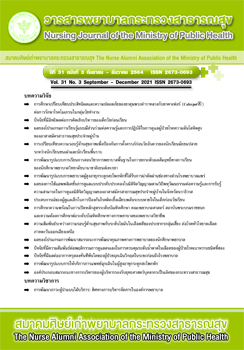Effect of Competencies Development Program on Nursing Quality Improvement of Nursing Students
Main Article Content
Abstract
Quality improvement (QI) competency is considered an essential competency in the nursing profession. Information on teaching to improve QI competency of nursing students is limited. The purpose of this study was to examine the effect of a quality improvement program on QI competency, which includes knowledge, attitude, and skills related to QI. A quasi-experimental one-group pretest-posttest design was conducted. The sample was composed of 175 4th year nursing students of Boromarajonani Collage of Nursing, Sanpasithiprasong. The quality improvement program included a lecture (2 hrs), a workshop on evidence-based practice (7 hrs), and a nursing practicum (120 hrs.) integrated with clinical teaching. A self-administered QI competency questionnaire (20 items, 5 Likert scale) was completed before and after the QI program implementation. Mentors rated QI competency of the students after the QI program implementation. Descriptive statistics were used and a paired t-test analysis was conducted to assess the differences of the mean scores before and after the QI teaching program. It was found that significant improvement in QI competency and QI practice can be achieved in nursing students through the QI program. The mentor expressed that the students’ QI competency was at a high and highest level. The integration of the QI program for nursing into pre-graduation clinical instruction and nursing practicum has led to the development of quality improvement competencies in nursing.
Article Details
บทความและรายงานวิจัยในวารสารพยาบาลกระทรวงสาธารณสุข เป็นความคิดเห็นของ ผู้เขียน มิใช่ของคณะผู้จัดทำ และมิใช่ความรับผิดชอบของสมาคมศิษย์เก่าพยาบาลกระทรวงสาธารณสุข ซึ่งสามารถนำไปอ้างอิงได้
References
2. Pomare C, Churruca K, Ellis LA, Long JC, Braithwaite J. A revised model of uncertainty in complex healthcare settings: a scoping review. Journal of evaluation in clinical practice.2019;25(2):176-82.
3. De La Perrelle L, Radisic G, Cations M, Kaambwa B, Barbery G, Laver K. Costs and economic evaluations of quality improvement collaboratives in healthcare: a systematic review. BMC health services research. 2020;20(1):1-10.
4. Hill JE, Stephani A-M, Sapple P, Clegg AJ. The effectiveness of continuous quality improvement for developing professional practice and improving health care outcomes: a systematic review. Implementation Science. 2020;15(1):1-14.
5. Limpanyalert P. Patient safety in Thailand. global patient safety: Routledge;2018.175-89.
6. Tschannen D, Alexander C, Tovar EG, Ghosh B, Zellefrow C, Milner KA. Development of the nursing quality improvement in practice tool: advancing frontline nursing practice. Journal of nursing care quality. 2020;35(4):372-9.
7. Alexander C, Armstrong G, Barton A. Quality and safety education for nurses. Introduction to Quality and safety education for nurses, second Edition: Core competencies for nursing leadership and management: Springer Publishing Company;2018.p.39-64.
8. Sherwood G, Zomorodi M. A new mindset for quality and safety: The QSEN competencies redefine nurses’ roles in practice. Nephrology Nursing Journal.2014;41(1):15-22.
9. Murray M, Sundin D, Cope V. A mixed-methods study on patient safety insights of new graduate registered nurses. Journal of nursing care quality.2020;35(3):258-64.
10. Dotson BJ, Lewis L. Teaching the quality improvement process to nursing students. Journal of Nursing Education.2013;52(7):398-400.
11. James DH, Patrician PA, Miltner RS. Testing for quality and safety education for nurses (QSEN): reflections from using QSEN as a framework for RN orientation. Journal for nurses in professional development. 2017;33(4):180-4.
12. Sherwood G. Integrating quality and safety science in nursing education and practice. Journal of Research in Nursing.2011;16(3):226-40.
13. Maxwell KL, Wright VH. Evaluating the effectiveness of two teaching strategies to improve nursing students’ knowledge, skills, and attitudes about quality improvement and patient safety. Nursing education perspectives. 2016;37(5):291-2.
14. Jones CB, Mayer C, Mandelkehr LK. Innovations at the intersection of academia and practice: facilitating graduate nursing students’ learning about quality improvement and patient safety. Quality Management in Healthcare. 2009;18(3):158-64.
15. Doerner ME, Swenty CF. The effect of a perioperative clinical immersion on senior nursing students’ perception of readiness to practice: a quality improvement project. AORN journal.2019;109(2):193-200.
16. McComb SA, Kirkpatrick JM. Infusing systems and quality improvement throughout an undergraduate nursing curriculum. Journal of Nursing Education.2017;56(12):752-7.
17. Nickles D, Dolansky M, Marek J, Burke K. Nursing students use of teach-back to improve patients’ knowledge and satisfaction: A quality improvement project. Journal of Professional Nursing.2020; 36(2):70-6.
18. Melnyk BM, Morrison-Beedy D. Intervention research and evidence-based quality improvement: Designing, conducting, analyzing, and funding: Springer Publishing Company;2018.
19. QSEN Institute. competencies/pre-licensure-ksa. 2021 [cited 2021 1 January,].
20. Hamrin V, Vick R, Brame C, Simmons M, Smith L, Vanderhoef D. Teaching a systems approach: an innovative quality improvement project. Journal of Nursing Education.2016;55(4):209-14.
21. Gaffney MK, Chargualaf KA, Fowley S. Enhancing nursing studentsknowledge, skills, and attitudes toward quality improvement: Implementation of a hybrid activity. 2020.
22. Altmiller G. Teaching Quality Improvement in Prelicensure Education. Nurse educator. 2020;45(1):9-10.
23. Prasertsri N, Jirubpapa M, Charoennukul A. The effect of evidence-based practice (EBP) teaching program on the EBP competence of nursing students. Nursing Public Health and Education Journal Thai. 2016;17(3):145-55.(in Thai).

